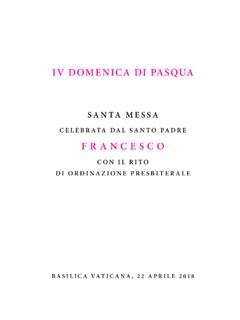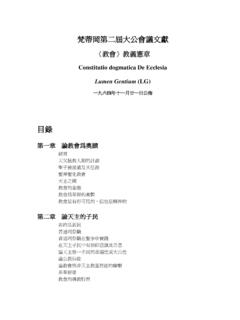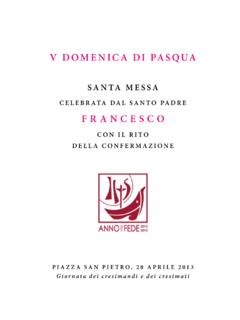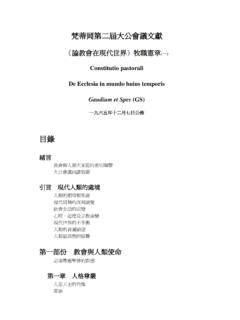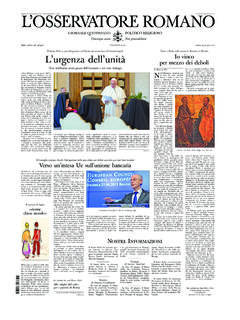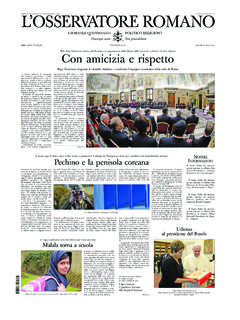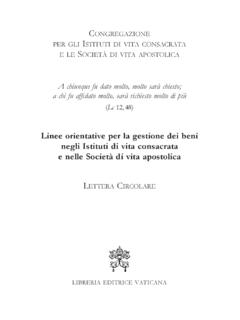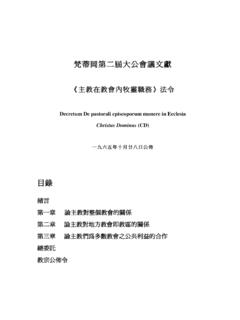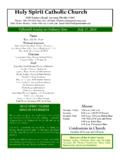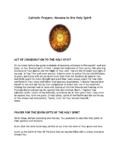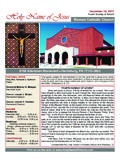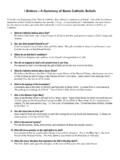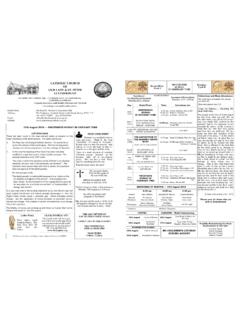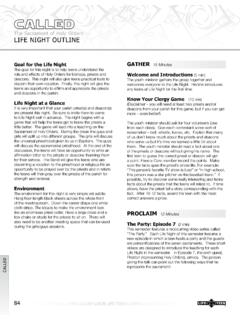Transcription of Compendium of the Letter of the Holy Father Pope …
1 Compendium of the Letter of the holy Father Pope Benedict XVI. to the Bishops, Priests, Consecrated Persons and Lay Faithful of the catholic church in the People's Republic of China The intent of this Compendium is to assist the reader in understanding the main points of the holy Father 's Letter and to respond, by quoting the words of His Holiness, to the questions that are frequently raised by Catholics. Introduction In his Letter , the holy Father repeatedly quotes the documents of Vatican II, especially Gaudium et Spes (GS), (the Pastoral Constitution on the church in the modern world), and Lumen Gentium (LG), (the Dogmatic Constitution on the church ). He also quotes from many writings of his predecessor, Pope John Paul II, as well as his own talks during the first three years of his Pontificate, plus some pronouncements from Vatican Congregations. The sources cited in 56 footnotes testify to an important fact: the catholic church in China is a member of the Universal church both essentially and historically (especially in post-Vatican II church history).
2 All that is said about the church of Jesus Christ may be applied to the catholic church in China. Speaking about the layout of the Letter , the first and second parts are arranged clearly and analytically, making it easy for people to grasp its main points and the path the readers should follow. The First Part, The Situation of the church Theological Aspects establishes the theological foundations of the Letter . This is the traditional style of the catholic church . From the Epistles of St. Paul, through every Ecumenical Council, documents have been like this: first come God's revelation and theological explanations, and then afterwards a link to ethical norms. These are the important responsibilities transmitted in the Second Part, Guidelines for Pastoral 1. Life . No matter whether there are seven theological aspects or eight pastoral guidelines, all are addressed to the church in China from the whole church throughout the entire world, in order to normalize the irregularities of the church situation in China and to help the Chinese ecclesial community to make the Risen Christ present to modern world ( and ).
3 After the text, there is a Table of Contents, which groups the 20 numbered sections under different headings: nn. 1-2 contain a greeting and the purpose of the Letter ; nn. 3-9. explain in detail 7 theological aspects of the situation of the church ; nn. 10-17 give 8 guidelines for pastoral life; and finally nn. 18-20 conclude with the revocation of special pastoral faculties, the establishment of a day of prayer for the church in China, and a final greeting. Before reading the text, reading these 20 headings first will enable one to make an intelligent guess at what the Letter says. This will certainly deepen one's comprehension of it. Reading the Letter with the heart of its author certainly enables one to understand it more thoroughly and deeply. What was in the holy Father 's heart when he wrote this Letter ? We can reply with three pairs of descriptive phrases taken from the Letter : concern both for knowledge and feelings, the presence of both truth and love, and promoting both the Eucharist and the hierarchy.
4 To restate it a little more clearly, the Letter is not only intelligent and reasonable, it is also an emotionally moving document. These are the true feelings of a pastor and a Father . 2. Questions and Answers 1. To whom is the Letter addressed? To the Bishops, Priests, Consecrated Persons and Lay Faithful of the catholic church in the People's Republic of China (Title of the Letter ) . 1. 2. What is the Purpose of the Letter ? It is to express that You are present in my heart and in my daily prayer and how deep is the relationship of communion that unites us spiritually ( ) and to express his fraternal closeness as well as his admiration for the great sufferings undergone for the sake of Jesus Christ ( ). The holy Father , writing as the Successor of Peter and universal Pastor of the church , wishes through this Letter to offer some guidelines concerning the life of the church ( ).
5 The Letter responds to numerous concrete questions raised by people in recent years, such as the tensions and divisions within the church and with the Chinese civil society (6), the function of national organizations (7), the appointment of Bishops and the exercise of their pastoral ministry (8 to 10), the celebration of the Sacraments (10) and also the recognition and circumscription of ecclesial provinces and dioceses (11). It joyfully manifests the sincere gratitude for the faithfulness offered, in the past and in the present, by the Chinese catholic Community ( ). It confirms the faith of the Chinese Catholics and favors their unity ( ). It expresses the holy Father 's hope to engage in respectful and constructive dialogue with the Chinese authorities ( ). 3. Into how many parts is the Letter divided? The Letter is divided into two parts: the first is entitled The Situation of the church : Theological Aspects ; the second is entitled Guidelines for pastoral life.
6 1. The Letter contains messages for the Chinese Government authorities ( ) as well. 3. 4. What is the current social situation in which the church in China finds herself? The pressure to attain the desired and necessary economic and social development and the search for modernity are accompanied by two different and contrasting phenomena, both of which should nonetheless be evaluated with equal prudence and a positive apostolic spirit. On the one hand, especially among the young, one can detect a growing interest in the spiritual and transcendent dimension of the human person, with a consequent interest in religion, particularly in Christianity. On the other hand, there are signs, in China too, of the tendency towards materialism and hedonism, which are spreading from the big cities to the entire country ( ). In China also the church is called to be a witness of Christ, to look forward with hope, and - in proclaiming the Gospel - to measure up to the new challenges that the Chinese People must face ( ).
7 5. What is the holy Father 's vision for a dialogue between the holy See and the Chinese government? The holy Father , who regards the entire Chinese People with sincere admiration and sentiments of friendship, realizes that the normalization of relations with the People's Republic of China requires time and presupposes the good will of both parties. For its part, the holy See always remains open to negotiations, so necessary if the difficulties of the present time are to be overcome ( ). The catholic church seeks no privilege from China and its leaders, but solely to dialogue, in order to build a relationship based upon mutual respect and deeper understanding ( ). The catholic church sincerely proposes to offer, once again, humble and disinterested service in the areas of her competence, for the good of Chinese Catholics and for the good of all the inhabitants of the country ( ).
8 The catholic church which is in China does not have a mission to change the structure or administration of the State. She has to play her part through rational argument and she has to reawaken the spiritual energy without which justice, which always demands sacrifice, cannot prevail and prosper. A just society must be the achievement of politics, not of the church . Yet the promotion of justice through efforts to bring about openness of mind and will to the demands of the common good is something which concerns the church deeply ( ). 4. In the light of these unrenounceable principles, the solution to existing problems cannot be pursued via an ongoing conflict with the legitimate civil authorities; at the same time, though, compliance with those authorities is not acceptable when they interfere unduly in matters regarding the faith and discipline of the church . The civil authorities are well aware that the church in her teaching invites the faithful to be good citizens, respectful and active contributors to the common good in their country, but it is likewise clear that she asks the State to guarantee to those same catholic citizens the full exercise of their faith, with respect for authentic religious freedom ( ).
9 6. What are the other messages to the Chinese authorities that the holy Father 's Letter conveys? The holy Father trusts that an accord can be reached with the Government so as to resolve certain questions regarding the choice of candidates for the episcopate, the publication of the appointment of Bishops, and the recognition concerning civil effects where necessary of the new Bishops on the part of the civil authorities ( ). The holy See is prepared to address the entire question of the circumscriptions and ecclesiastical provinces in an open and constructive dialogue with the Chinese Episcopate and . where opportune and helpful with governmental authorities (11). The holy Father renews his earnest wish (cf. section 4, paragraphs 2, 3, 4) that in the course of a respectful and open dialogue between the holy See and the Chinese Bishops on the one hand, and the governmental authorities on the other, the difficulties mentioned may be overcome and thus a fruitful understanding may be reached that will prove beneficial to the catholic community and to social cohesion ( ).
10 7. What does the holy Father say to the Catholics who suffered for the faith in China? The holy Father deeply appreciates their witness. His appreciation flows through the whole Letter as follows: I wish, therefore, to convey to all of you the expression of my fraternal closeness. With intense joy I acknowledge your faithfulness to Christ the Lord and to the church , a faithfulness that you have manifested sometimes at the price of grave sufferings', since it has been granted 5. to you that for the sake of Christ you should not only believe in him but also suffer for his sake'. (Phil 1:29) ( ). The word of God helps us, once again, to discover the mysterious and profound meaning of the church 's path in the world. In fact the subject of one of the most important visions of the Book of Revelation is [the] Lamb in the act of opening a scroll, previously closed with seven seals that no one had been able to break open.
